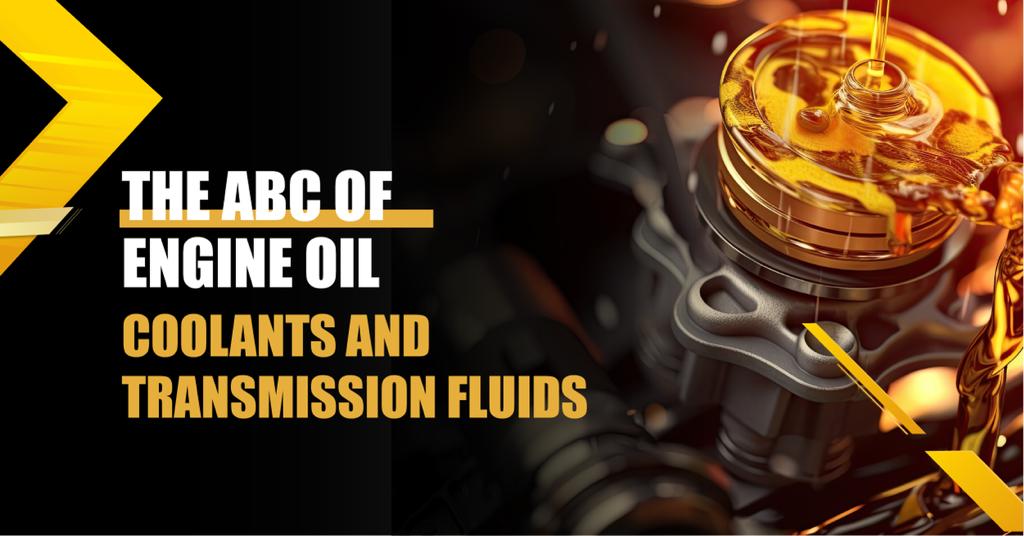If you own a car, you probably know that it needs regular maintenance to keep it running smoothly and safely. One of the most important aspects of car maintenance is checking and changing the fluids that lubricate and cool the engine and transmission. These fluids are essential for the performance, efficiency and longevity of your car’s components. But do you know what these fluids are, what they do and how often you should change them? In this blog, we will explain the ABC of engine oil, coolants and transmission fluids.
Engine Oil
Engine oil is the lifeblood of your car’s engine. It lubricates the moving parts of the engine, reduces friction and wear, prevents corrosion and rust, cleans the engine from dirt and debris, and helps to dissipate heat. Engine oil also contains additives that enhance its properties and protect the engine from various conditions.
There are different types of engine oil, such as conventional, synthetic, semi-synthetic and high-mileage. The type of oil you should use depends on your car’s make, model, age, mileage and driving conditions. You can find the recommended oil type and viscosity for your car in your owner’s manual or on the oil cap under the hood.
You should check your engine oil level regularly, at least once a month or before a long trip. To do this, park your car on a level surface, turn off the engine and wait for a few minutes. Then pull out the dipstick, wipe it clean with a rag, insert it back into the oil reservoir and pull it out again. The oil level should be between the minimum and maximum marks on the dipstick. If the oil level is low, add some oil of the same type and viscosity as the one in your engine. Do not overfill the oil reservoir, as this can cause damage to your engine.
You should also change your engine oil and filter according to your car manufacturer’s recommendations. Changing your engine oil regularly will ensure that it maintains its optimal properties and does not become contaminated or degraded. To change your engine oil, you can either take your car to a professional service center or do it yourself if you have the necessary tools and skills. You will need to drain the old oil from the engine, replace the oil filter, refill the engine with new oil and dispose of the used oil properly.
Engine Coolants
Engine Coolants are liquids that circulate through the cooling system of your car’s engine. They absorb heat from the engine and transfer it to the radiator, where it is released to the air. Engine Coolants also prevent freezing in cold weather, boiling in hot weather, corrosion and rust in the cooling system components.
There are different types and colours of coolants, such as green, orange, red, yellow and blue. The type of coolant you should use depends on your car’s make, model, age and cooling system specifications. You can find the recommended coolant type for your car in your owner’s manual or on the coolant reservoir cap under the hood.
You should check your coolant level regularly, at least once a month or before a long trip. To do this, park your car on a level surface, turn off the engine and wait for it to cool down completely. Then open the hood and locate the coolant reservoir. The coolant level should be between the minimum and maximum marks on the reservoir. If the coolant level is low, add some coolant of the same type as the one in your cooling system. Do not mix different types of coolants, as this can cause chemical reactions that can damage your cooling system.
You should also change your coolant according to your car manufacturer’s recommendations. Changing your coolant regularly will ensure that it maintains its optimal properties and does not become contaminated or degraded. To change your coolant, you can either take your car to a professional service center or do it yourself if you have the necessary tools and skills. You will need to drain the old coolant from the cooling system, flush it with water or a special cleaner, refill it with new coolant and bleed any air bubbles from the system.
Transmission Fluids
Transmission fluids are liquids that lubricate and cool the transmission of your car. The transmission is a complex system that transfers power from the engine to the wheels through gears and clutches. Transmission fluids help to reduce friction and wear between these components, prevent overheating and corrosion, improve shifting performance and fuel efficiency.
There are different types of transmission fluids, such as automatic transmission fluid (ATF), manual transmission fluid (MTF), continuously variable transmission fluid (CVT) and dual clutch transmission fluid (DCT). The type of transmission fluid you should use depends on your car’s make, model, age and transmission type. You can find the recommended transmission fluid type for your car in your owner’s manual or on the transmission dipstick or filler cap under the hood.
You should check your transmission fluid level regularly, at least once a month or before a long trip. To do this, park your car on a level surface, turn on the engine and let it run for a few minutes. Then open the hood and locate the transmission dipstick or filler cap. The transmission fluid level should be between the minimum and maximum marks on the dipstick or cap. If the transmission fluid level is low, add some transmission fluid of the same type as the one in your transmission. Do not overfill the transmission fluid reservoir, as this can cause damage to your transmission.
You should also change your transmission fluid according to your car manufacturer’s recommendations. Changing your transmission fluid regularly will ensure that it maintains its optimal properties and does not become contaminated or degraded. To change your transmission fluid, you can either take your car to a professional service center or do it yourself if you have the necessary tools and skills. You will need to drain the old transmission fluid from the transmission, replace the transmission filter, refill the transmission with new transmission fluid and adjust the fluid level.
Conclusion
Engine oil, coolants and transmission fluids are vital fluids for your car’s performance, efficiency and longevity. Regular checks will keep your car running smoothly and safely for a long time.
If you are looking for high-quality and reliable fluids for your car, you should consider LubePlus Energies. LubePlus Energies is a leading brand that offers a large variety of engine oils, coolants and transmission fluids that suit different types of cars, engines and driving conditions. LubePlus Energies fluids are designed to provide optimal lubrication, cooling, protection and performance for your car’s components. You can find LubePlus Energies fluids at your nearest service center or order online. LubePlus Energies is the best choice for your car’s fluids. Try it today and see the difference for yourself.






